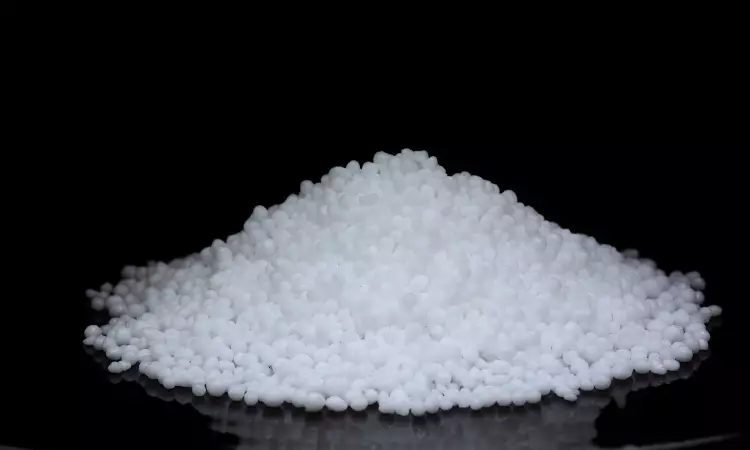Urea Market Study and Driving Factors
Urea or carbamide (CH4N2O) is a safe nitrogenous compound that is very useful. It occurs naturally as a molecule produced by protein metabolism and is abundantly present in mammalian urine. It contains a carbonyl group linked with two amine groups with osmotic diuretic activity. It functions like a human metabolite, a flour treatment agent, a Daphnia magna metabolite, an Escherichia coli metabolite, a Saccharomyces cerevisiae metabolite, a mouse metabolite and primarily a fertilizer. The monocarboxylic acid amide is functionally related to carbonic acid, a tautomer of carbamimidic acid.
The compound appears to be a solid white crystal or pellet with no odour. It is the final product of protein metabolism and a waste product with no physiological function. It is found in the urine of all mammals as well as their bile, milk, blood, and perspiration. It has a molar mass of 60.06 g/mol and a density of 1.335 g /cc. It is non-combustible and non-toxic. It dissolves in water with a water solubility of 1.1 kg/L and has a melting point of 133–135 ºC.
Urea is widely used as a key raw material in many industries and is commonly used in fertilizers. It is employed as a feed supplement and a starter for manufacturing plastics and drugs. It finds use as a stabilizer in a majority of nitrocellulose explosive products as well as used in the making of high explosive materials like urea nitrate. In lanthanide chemistry, it is employed as an important reagent. It also finds application in cosmetic and personal care products as a key ingredient, for instance, in creams/ointments used for rehydration, hair removal creams and dish soaps. Its also added to pretzels as a browning agent and to manufacture melamine. Also, any stomach bacteria can be detected using the urea breath test.
Urea Production Cost Study
- From Phosgene: In this reaction, the primary ingredients Phosgene and Ammonia are reacted to produce urea. To carry out this reaction, secondary ammonia is employed, which is followed by the formation of isocyanate as an intermediate.
- From Bosch–Meiser urea process: This process includes two equilibrium reactions. The first one is exothermic, also called carbamate formation, and the second one is endothermic, called urea conversion. During the method, Ammonia and Carbon Dioxide get transformed into Urea, and the net reaction is exothermic.
Key Players Influencing the Urea Prices
- QAFCO or Qatar Fertiliser Company
- Yara International ASA
- Koch Fertilizer, LLC
- SABIC
- OCI N.V.
- CF Industries Holdings, Inc.
- EuroChem Group AG
- OSTCHEM
- PotashCorp
- China National Petroleum Corporation
- Ruixing Group Co., Ltd
- Luxi Chemical Group Co., Ltd.
- Shandong Hualu-Hengsheng Chemical Co., Ltd.
- Sichuan Lutianhua Co., Ltd. (Lutianhua)
Urea Price Trend Analysis
North America
Urea prices in the market in the US persistently declined in recent months due to the strong drop in raw material costs. As an aftermath of unfortunate trading fundamentals as well as muted demand, the prices of urea kept plummeting. As per the statistics, the cost of feedstock natural gas dropped by about 15% recently, and this continued in later months. Producers could offer deals to draw offtakes from niche downstream consumers as a consequence of the flat feedstock prices that impacted the pricing trends in major importing nations such as India and the USA. in the domestic market, and Nitrogen production declined on the back of the country’s inflation and drought conditions. The shortage of labour in the US market continued, though the cost of operation stayed positive.
Asia Pacific
The urea pricing trend in the Asia Pacific region stayed sunk because of the shortage of demand from downstream fertilizer markets. There were anticipations for Urea fertilizer demand during India’s rabi season, but this demand stayed bearish. Due to the shortage of demand from downstream Melamine industries within significant importing countries such as South Korea and Taiwan, spot materials repositioned from the Middle East, Southeast Asia, and North Africa to Europe and Africa. This time frame has by far been the worst one in history for Urea pricing because of the lower demand from the Asia Pacific region’s industrial and agricultural consumers.
Europe
Prices of urea displayed mixed pricing sentiments recently since the feedstock Ammonia has continued to follow a volatile movement because of the wavering Natural gas prices. A few of the nitrogen-based fertilizer production facilities in Europe closed down because of the increasing costs of upstream natural gas. In addition, the supply chain stayed in disarray as a result of clashing views based on freight prices and the restricted quantity of containers available. Later, Russia increased all nitrogen fertilizers import quotas, which led to a rise in regional supply. The market for downstream fertilizer reacted in a consistent manner with the shifting demand later.
Recent Developments in the Urea Industry
- The Foundation Stone For The Fifth Nano Urea Plant In Deoghar, India, Laid By Amit Shah
Amit Shah, Union Home Minister in India, has laid the INR 450 crore nano urea plant’s foundation stone as well as the township of the Indian Farmers Fertiliser Cooperative (IFFCO) in Deoghar, Jharkhand. This plant will be India’s fifth nano urea plant. The first nano urea plant in the world was inaugurated by Prime Minister Narendra Modi in Gujarat in 2021. As per the Union Minister, the product will prove beneficial for farmers and is already being exported across five nations.
In this Urea market analysis, an in-depth study of the commodity has been covered, including its market analysis, key driving factors, production study, pricing trajectory and local developments in the sector. This write-up can help provide some insight to the readers and key industry players regarding the latest movements of the industry, focusing on prices, the supply-demand factors influencing it and key players that influence the market’s growth. As per the write-up, the main sector propelling the industry’s demand is its usage of fertilisers that are extensively used in the agricultural sector.
